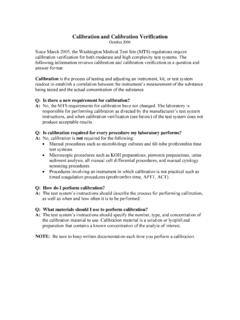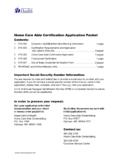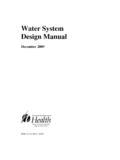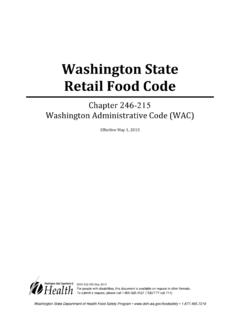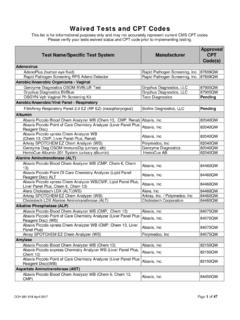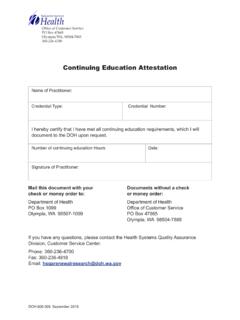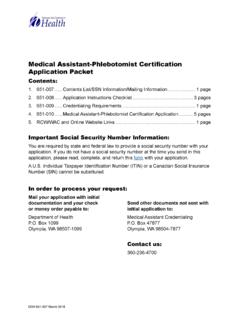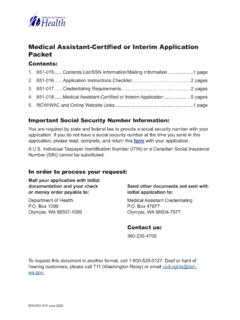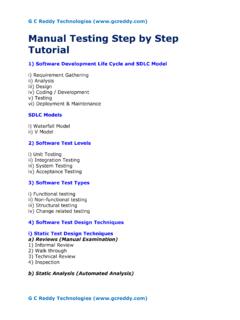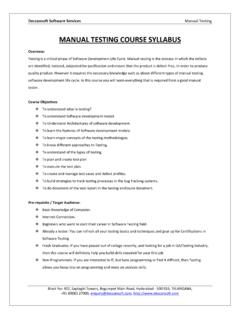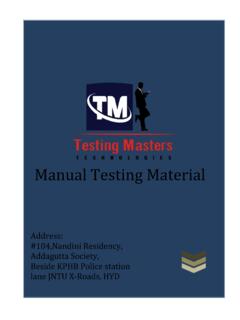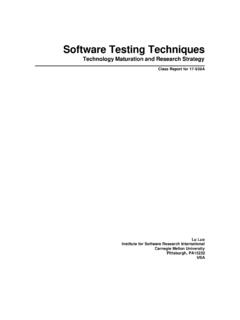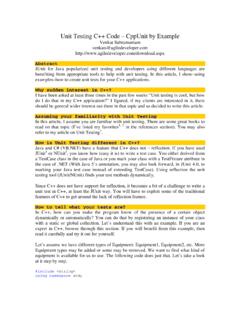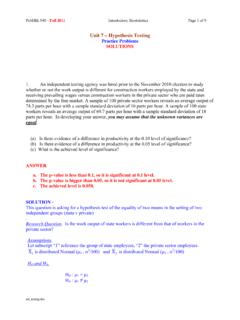Transcription of Long-Term Care Facility Testing for Staff and Residents
1 Interim Recommendations for SARS-CoV-2 Infection Prevention and Control in Healthcare Settings 2022 Updated October 31, 2022 DOH 420-391 0 TABLE OF CONTENTS CHANGE LOG .. 2 BACKGROUND AND PURPOSE .. 3 KEY INFORMATION .. 3 INFECTION PREVENTION AND CONTROL PROGRAM AND PLAN .. 4 ELEMENTS OF COVID-19 PREVENTION IN ALL HEALTHCARE SETTINGS .. 5 SCREENING .. 5 HAND 6 ENVIRONMENTAL INFECTION CONTROL - CLEANING AND 6 VENTILATION .. 7 PERSONAL PROTECTIVE EQUIPMENT (PPE) AND TRANSMISSION-BASED PRECAUTIONS (TBP) .. 8 Table 1: PPE Patients, HCPs, and Visitors Should Wear in Healthcare Settings .. 9 Table 2: HCPs: How to Use PPE .. 10 Source Control .. 11 Table 3: Source Control and PPE Protection.
2 12 Precautions During and Following Aerosol Generating and Other Procedures .. 15 Patient Isolation and Quarantine .. 19 HEALTHCARE PERSONNEL EXPOSURE AND EXCLUSION FROM WORK .. 21 Mitigating Healthcare Worker Staffing Shortage .. 21 TRANSFERRING BETWEEN FACILITIES .. 25 25 Testing Prioritization .. 26 Determining Exposure .. 26 GUIDANCE FOR SPECIFIC SETTINGS .. 28 Long-Term CARE FACILITIES .. 28 Cohorting Strategies for Long-Term Care Facilities .. 30 Testing in Long Term Care Facilities .. 34 Visiting in Long-Term Care Facilities .. 35 BEHAVIORAL HEALTH .. 36 Cohorting .. 36 Source Control .. 36 Alcohol-based Hand Sanitizer .. 37 Transfers .. 37 Visitation .. 37 ACUTE CARE.
3 37 Visitor Guidance for Inpatient Hospitals and Outpatient 37 ADDITIONAL RESOURCES .. 40 OUTBREAK DEFINITION IN HEALTHCARE SETTINGS .. 40 1 OUTBREAK AND PREPAREDNESS CHECKLISTS .. 40 Long-Term Care Checklist .. 40 Considerations for Memory Care .. 42 SIGNS AND OTHER TOOLS .. 56 WSHA Aerosol Contact Precaution Sign .. 56 Aerosol Generating Procedure Sign .. 56 Quarantine Sign .. 56 COVID-19 Announcement for Visitors .. 56 Employee Callout Log .. 56 Breakroom Safety Sign .. 56 Maximum Occupancy Sign .. 56 DEFINITIONS .. 57 ABBREVIATIONS .. 62 MORE COVID-19 INFORMATION AND RESOURCES .. 63 2 Change Log May 16, 2022 Initial posting October 31, 2022 Updated management of Staff , visitors, and patients entering a Facility .
4 Updated to reflect that vaccination status is no longer used to inform source control, screening Testing , or post-exposure recommendations Updated circumstances when use of eye protection is recommended Updated recommendations for Testing frequency. Clarified that screening Testing of asymptomatic healthcare personnel, including those in nursing homes, is at the discretion of the healthcare Facility Updated to note that, in general, asymptomatic patients no longer require empiric use of Transmission-Based Precautions following close contact with someone with SARS-CoV-2 infection Updated to note that, in general, Staff do not require restrictions from work following a higher risk exposure to someone with SARS-CoV-2 infection Updated screening Testing recommendations for nursing home admissions Updated to continue to include Assisted Living, Group Homes.
5 And other Residential Care Settings 3 Background and Purpose This document includes Washington State Department of Health (DOH) recommendations to prevent transmission of severe acute respiratory syndrome coronavirus 2 (SARS-CoV-2), the virus that causes coronavirus disease 2019 (COVID-19) in healthcare settings. Healthcare settings should use these recommendations to create flexible policies specific to their Facility based on their individual risk assessment reflecting CDC s community levels of transmission. In general, healthcare facilities should consider checking their local Community Transmission level weekly. When a healthcare Facility s Community Transmission level increases and the increase results in a change in the recommended interventions, the new interventions should be implemented as soon as possible.
6 When a healthcare Facility s Community Transmission levels decrease into a category that corresponds with relaxation of an intervention, facilities should confirm the reduction is sustained, by monitoring for at least two weeks, before relaxing the intervention. In general, healthcare settings should follow Centers for Disease Control and Prevention (CDC) guidance to prevent transmission of SARS-CoV-2: Interim Infection Prevention and Control Recommendations for Healthcare Personnel (HCP) During the COVID-19 Pandemic Overview of Testing for SARS-CoV-2, the virus that causes COVID-19 Interim Guidance for Managing HCP with SARS-CoV-2 Infection or Exposure to SARS-CoV-2 Strategies to Mitigate HCP Staffing Shortages Summary for Healthcare Facilities.
7 Strategies for Optimizing the Supply of Personal Protective Equipment (PPE) during Shortages The guidance in this document is not regulatory in nature except when required by a regulatory agency such as Washington State Labor & Industries (L&I), Washington State Department of Social and Health Services (DSHS), DOH-Health Systems Quality Assurance (HSQA), and Centers for Medicaid and Medicare Services (CMS). When creating policy and procedures, healthcare settings should ensure they are meeting regulatory requirements. The guidance in this document is interim in nature and, as such, will be updated with changes in national and state guidance and most recent evidence and data.
8 Changes will be summarized in the change log. Key Information DOH COVID-19 public health reporting and surveillance guidelines provide useful key information about COVID-19 including information on incubation period, mode of transmission, and period of communicability. For updated case counts: Washington: US: #cases_casesinlast7days Global: 4 Infection Prevention and Control Program and Plan Healthcare facilities should have a person dedicated to infection prevention and control and a plan to mitigate risk of infection transmission. Some healthcare settings have specific regulatory requirements for infection prevention and control. Please refer to regulatory agencies (L&I, DSHS, HSQA, and CMS) requirements for regulatory requirements.
9 An infection prevention and control program should at minimum include: 1) Guidelines, policies, and procedures 2) Education and training 3) Surveillance 4) Monitoring, audit, and feedback From: WHO s core components of infection prevention and control program 5 Elements of COVID-19 Prevention in all Healthcare Settings Screening Ensure that everyone entering the Facility is aware of infection prevention and control practices in the Facility . Follow CDC recommendations to establish a process to make everyone entering the Facility aware of recommended actions to prevent transmission, regardless of their vaccination status, if they meet any of the following three criteria so that they can be properly managed: A positive viral test for SARS-CoV-2, or Symptoms of COVID-19, or Close contact with someone with SARS-CoV-2 infection (for patients and visitors) or a higher-risk exposure (for HCP).
10 Options could include (but are not limited to): For HCP, instruct HCP to report any of the above criteria to occupational health or other point of contact designated by the Facility so they can be properly managed. See CDC s HCP Exposure and Exclusion from Work and DOH Mitigating Healthcare Worker Staffing Shortage for guidance managing HCP with SARs-Cov-2 infection or exposure, Post visual alerts and signage at the entrance and strategic places. Include a publication or posting date to alert people that signage reflects current recommendations Provide instructions when scheduling appointments Facilities may choose to conduct active screening such as individual screening on arrival at the Facility ; or implementing an electronic monitoring system in which individuals can self-report any of the above before entering the Facility .
